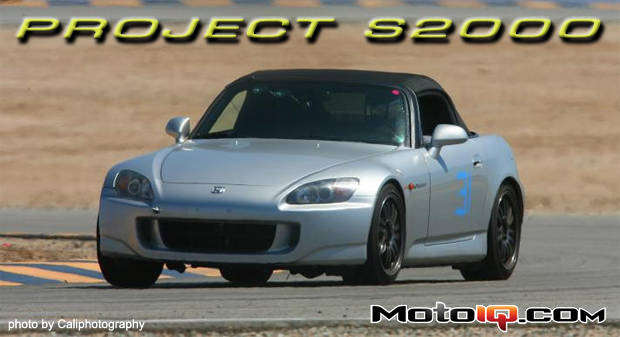 |
Project S2000 – Track Testing Revised KW Clubsports and Earl’s Oil Cooler
By Khiem Dinh
Khiem Dinh is an engineer for Honeywell Turbo Technologies at the time of this writing. All statements and opinions expressed by Khiem Dinh are solely those of Khiem Dinh and not reflective of Honeywell Turbo Technologies.
The last track outing for the S2000 showed a few deficiencies still existed in the setup. The most problematic from a reliability standpoint was the scorching oil temperature. From a speed standpoint, the car was still very loose (last track update). Going back to the beginning of the project, you’ll remember that we switched the tire sizing from a stock staggered setup (215 widths up front, 245 on the rear) to an even, or non-staggered, setup utilizing 245 width tires front and rear (Part I).
Acura were the first to pioneer this setup in modern Prototype racing on their car raced in the American LeMans Series. Audi and Peugeot have since followed suit running tires that are basically even width front and rear on the R18 (360f/370r) and 908 (370f/370r) prototypes respectively. In anticipation of the increased front grip with the wider front tires on the S2000, we added a stiffer Whiteline front sway bar and removed the rear bar (Part II). As I’ve learned the car over time and started pushing harder and harder (my previous cars were FWD and AWD), I hit the limit of grip and determined I needed more setup adjustment to address the oversteer tendencies.
The next logical components to change were the front springs. The KW Clubsports were designed for a stock S2000 using standard tire sizing, not for cars running a non-staggered setup. After researching what many other track-only S2000s were running for spring rates, I decided to increase the original KW Clubsports spring rate of 100N/mm to 120N/mm. Yeah, KW does it a little different and rates springs as N/mm instead of Kg/mm. If you want to get super geeky, I guess it should be Kgf/mm which is kilogram-force/mm because a kilogram is a unit of mass on its own and you need to multiply it by gravity to make it a force. So a Kgf implies a kilogram of mass multiplied by the acceleration of gravity to give you a force. It’s good ole F = ma. 1 Newton = 1 kilogram x 9.81 m/s^2 (acceleration due to gravity on earth). So KW is technically more correct by rating its springs in N/mm. Anyways, back on topic.
To test the setup changes for the Earl’s oil cooler (Part IX, or 9 for those of you that don’t do roman numerals) and suspension, I hit up another Speed Ventures auto-x and an Industry Track Day put on by the guys at Mackin Industries (Edward Lee is da man!); Industry Track Day is open only to those somehow related to the automotive industry, so it’s a fun day with your peers.
 |
| Earl’s Temp-A-Cure oil cooler with Ano-Tuff fittings and Pro-Lite 350 hoses. |
On the drive to the auto-x, I was able to get my first real evaluation of the oil cooler. On the highway with an ambient temperature of about 70F, the oil temperature would hover in the 72C-75C range which is approximately 162F-167F. The Mocal thermostat was rated at 180F, so it’s just about right. The temperature is cooler than I would actually like it, but that was the only temperature thermostat available from Mocal in the sandwich adapter design.(EDIT: it turns out Mocal has one at 200F and it is a special order item. I wish I had known this before as I would have gone for the 200F one) On the stock setup, the oil temperature was about 90C/194F, so the oil cooler created a significant temperature drop. With an ambient air temperature of about 85F and cruising with A/C on the highway, the stock setup would result in an oil temperature of 100C. The new oil cooler setup reduced the temperature down to 85C. One other little change was the coolant temperature. It use to hover at 89C-90C, and now it’s a bit cooler at 87C-88C. This is not a surprise as hot oil is no longer adding heat to the coolant system as was the case with the stock oil/coolant heat exchanger donut.
During the auto-x, I got to test out the other feature of my oil cooler setup which is the built-in oil cooler fan. After each run, the oil temperature would peak at about 95C. While waiting in the staging lanes for my next run, I turned on the A/C in order to turn on the fan mounted to the oil cooler. With the fan running, it dropped the oil temperature down to 85C after a few minutes in the staging lanes. So it worked just like I thought it would.
The last concern with the oil cooler setup was the resulting oil pressure due to the pressure losses incurred by the extra plumbing and oil cooler core. I’m happy to report that the oil pressure barely changed. At idle with an oil temperature of 90C, the oil pressure went from ~1.6 bar to ~1.5 bar, or a reduction of ~6%-7%. At cruising speeds, the oil pressure remained around 6 bar. The oil pressure reading fluctuates a lot at cruising speed on my sensor setup, so there’s no definitive number, but it seems to have dropped only a couple tenths of a bar out of about 6 bar of total pressure. The conclusion is my oil cooler setup has an insignificant oil pressure drop.




2 comments
What ride height did you set the car to with the KW Clubsports?
It’s been a while, but I recall about 13.5″ from wheel centerline to the fender.